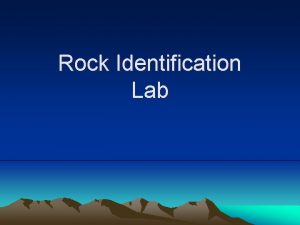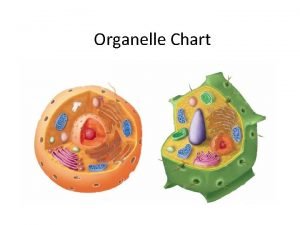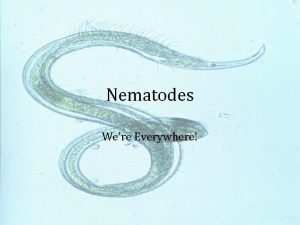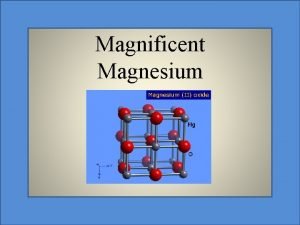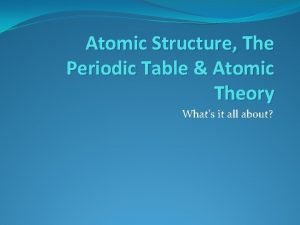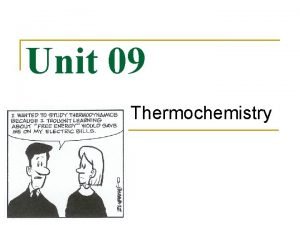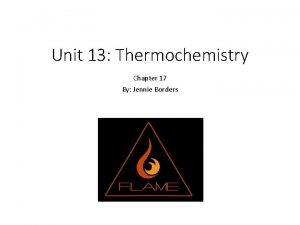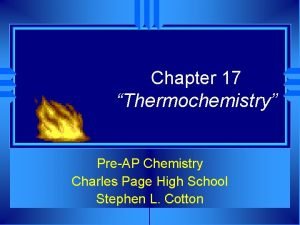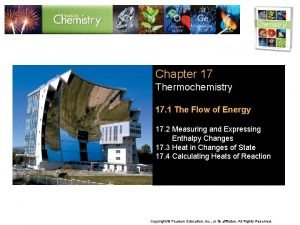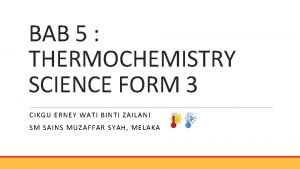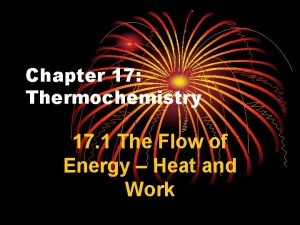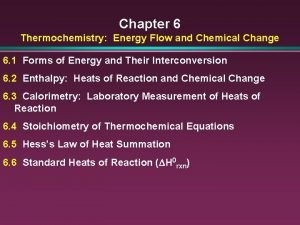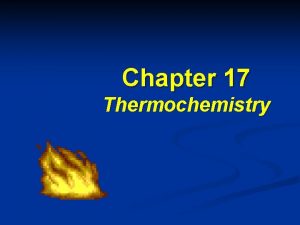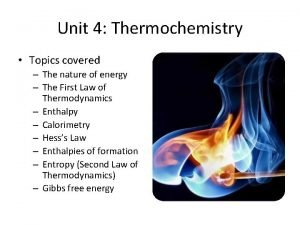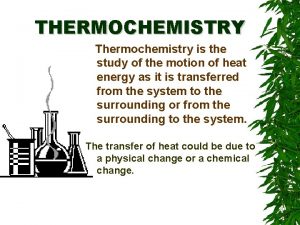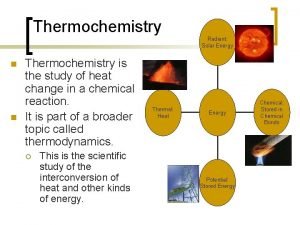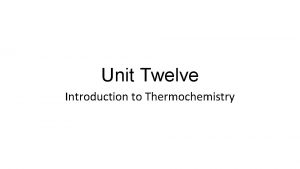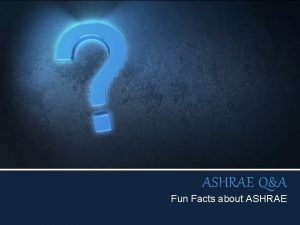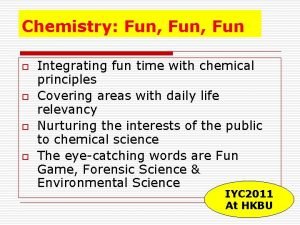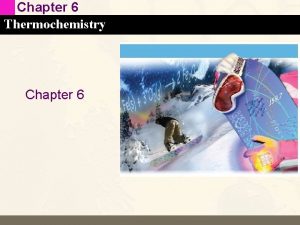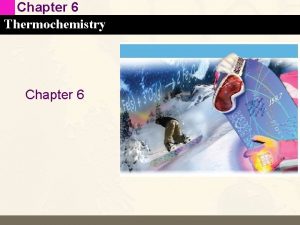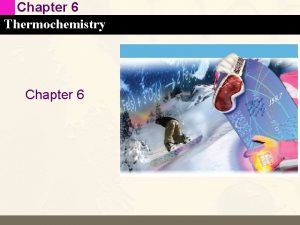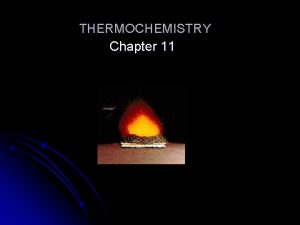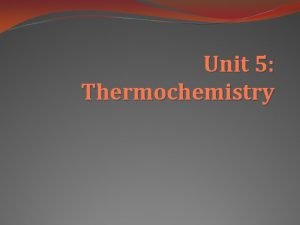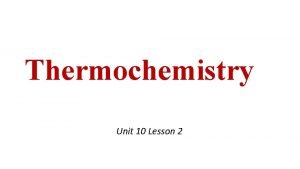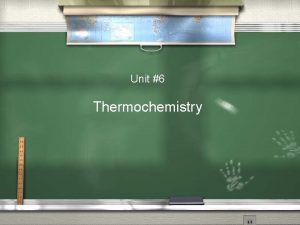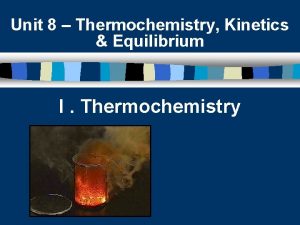Thermochemistry Unit 17 Chapter 17 Fun fact Thermochemistry



























- Slides: 27

Thermochemistry Unit 17 Chapter 17

Fun fact: • Thermochemistry is technically physics, and not chemistry…

First, some terminology • “The system” in chemistry is defined as the chemicals involved with reaction or heat change • “The surroundings” or “the environment” is where the heat goes or comes from – Ex) In a propane stove the system is the flame, and the air around it is the surroundings

• https: //www. youtube. com/watch? v=Gqt. UWy DR 1 fg&list=PL 1 R 4 f. AABv. X_P_QWo. VK 3 g 02 Mev z. Msy. Ri. Tt

Energy and heat… • Chemical potential energy is the energy stored in bonds. • Heat (q) is the energy that transfers from one system to another. • Heat (q) always FLOWS from a warmer object to a cooler object. • Thermochemistry is just the study for the FLOW of energy from one spot to another. – Follows the Law of Conservation of Energy • (Same as Law of Conservation of Mass, just now Energy)

Endothermic vs. Exothermic Process • Endothermic reactions are when the SYSTEM gains energy. – Heat goes IN. Endo means inside! • Exothermic reactions are when the SYSTEM loses energy – Heat goes OUT! EXO means outside! • Are you, human, endothermic or exothermic? • What about fire? • What about melting? !?

Two units to measure energy • A joule is the SI measure that is the measure of actual potential and kinetic energy – It’s actually a very small amount of energy, and its unit is J • A calorie is the non-SI measure that is the amount of energy needed to increase the temperature of 1. 00 g of water exactly 1. 00°C. – It’s still a very small number (1. 00 cal) so we use Cal (or 1000 cal. or 1 kcal) more. • 1 cal = 4. 184 J

Who cares? • Well, this is how we can actually measure the heat gained or lost by a system! – The more the temperature goes up, the more heat it released. (Or, the more the temperature goes down, the more heat it gained…) • This amount of energy it takes for the substance to increase energy is called SPECIFIC HEAT CAPACITY (C). C= heat (J) mass (g) x ΔT (°C)

What’s the C? What is it? • You burn 112 J of energy into an object with a mass of 34. 6 g, and you get a temperature change of 13. 5°C. • What would be the energy needed to heat 12. 5 g of iron up 150. °C?

So? • That means if we know energy, and mass, we can know how much the temperature goes up. • Or if we know how much mass, and how much temperature goes up, we can calculate energy!

Calculate the energy of your reaction yesterday…. • C= heat (J) mass (g) x ΔT (°C) • C = 4. 184 J/g*°C

• https: //www. youtube. com/watch? v=Ju. Wt. BRr. DQk • Or • https: //www. youtube. com/watch? v=EAgbkn. I DKNo

Calorimetry • Because the system (in this case the chemicals) releases (or gains) the energy into (or from) the system, we can measure the reaction by measuring the environment – A Calorimeter is an environment where the system can be measured by measuring the change in temperature of the environment • Ideally loses no energy to the environment outside • This allows us to measure the enthalpy (H) of the system, which is the heat content of a system at constant pressure. (Still, no work done. ) – q = ΔH (so, change in enthalpy is equal to heat)

The one equation to rule them all… • Is actually just a rearranged version of the one we did in 17. 1 • qsys = ΔH = -qsurr = - m x C x ΔT • If the system loses heat, the surrounding gains the opposite amount of heat. – Hence the negative sign…

There actually TWO types of calorimeters… • Constant pressure (reaction takes place in water, and we measure the water). – Like we did in class! • Constant volume (reaction occurs in gas) – The gas then reacts, and then heats the water around it. – Used to be called a “bomb calorimeter”, which sounds super cool, until you realize it’s not. • No work is done, so all the energy is moved as temperature changes (heat)!

A new type of balanced chemical equation results… • A thermochemical equation! – Has all the information of a balanced equation, but also shows the amount of energy that is released, or that changes. • The “Heat of reaction” – Are assumed to be at 1 atm and 25°C, and 1 mol. • Exothermic reactions will have negative enthalpy values, while endothermic will be positive. – The state will be important, because different states actually produce different energy

Heat of Combustion is the same as heat of reaction… • It is just for a combustion reaction ( + O 2) • Basically always negative, and is measured for 1 mole of the chemical that combines with O 2 at 25°C at 1 atm. • Other than that, it’s the same.

So, let’s burn some ethanol… • If I burn 25 g of ethanol, how much heat is lost by the system? • How much would that increase the temperature of a liter of water?

Heat of Change in State • In addition to taking energy to increase temperature, it also takes (or releases) energy to change states. • It takes energy to change to the more disorganized state. (Solid is the most organized, gas is the least organized. ) • The heat to melt is called the molar heat of fusion. (in k. J/mol. ) • The heat to freeze is called the molar heat of solidification – It is always the opposite of the heat of fusion

The same rules apply for vaporization and condensation. • Vaporization takes energy from the surroundings, condensation gives off energy, and they are always equally opposite.

Why? • By turning a chemical from a solid to a liquid (or a liquid to a gas) you are breaking attractions, and that takes energy away from the system to do it. • Have you ever noticed how the snow stays on the grass much longer than it stays on the pavement? – The grass doesn’t have as much heat transfer as the pavement.

Alright, fine, some problems! • How much energy would it take to melt 360. 5 g of water? – Heat of fusion is on page 522 • How much energy would be released from condensing 25. 2 kg of ethanol?

There is also energy in forming solutions. • Attractions are broken, and new attractions are made, so energy is released or absorbed by the system. • This is called the “Heat of Solution”, and can be positive or negative. – Just 36. 5 g (less than 1 oz. ) of pure HCl put in water can release 75, 000 J of energy. Which is why you always SLOWLY pour acids into water. • Let’s see how much energy is produced by putting solid Na. OH into water…

Heat of solution calculations • How much heat would be generated by dissolving 1. 54 mol. of Na. OH? (Page 525 has the molar heat of solution for Na. OH. ) – If it were in 100. 0 m. L of water, how much would the temperature increase? • What is the heat of solution of 166 g of ammonium nitrate (pg 525)? – How much would that decrease the temperature of 235 m. L of water?

Hess’s Law of Heat Summation • Why is enthalpy H? WHY? Seriously, man, what the heck? • Answer: Hess! • Hess said that it didn’t matter how the reaction occurred, all that mattered was the starting and ending states. • So: Heat of formation ΔHf 0 = ΔHf 0 (products) - ΔHf 0 (reactants)

Pure elements, yo… • Have a ΔHf 0 = 0. 0 k. J/mol in their room temperature state. • Compounds will have a ΔHf 0 that is not zero. • Basically, if a pure element in it’s periodic table state, it’s going to be zero, everything else is a number • Same 2 equations apply, yo.

Some reactions… • John has unwisely decided to make 10, 000. g of water. How much energy will be released? • Thermite is 760. 0 g aluminum powder plus iron oxide in a single replacement reaction. How much energy is produced?
 Igneous rock fun fact
Igneous rock fun fact Organelle function chart
Organelle function chart Nematoda interesting facts
Nematoda interesting facts Fun fact about protists
Fun fact about protists Plant adaptations temperate deciduous forest
Plant adaptations temperate deciduous forest Magnesium fun fact
Magnesium fun fact Urinary system model
Urinary system model Isotopic notation example
Isotopic notation example Fun fact about bees
Fun fact about bees 10 facts about hernan cortes
10 facts about hernan cortes Rainforest fun fact
Rainforest fun fact Good teapot vs bad teapot
Good teapot vs bad teapot Chemistry semester 2 review unit 12 thermochemistry
Chemistry semester 2 review unit 12 thermochemistry Unit 9 thermochemistry
Unit 9 thermochemistry Chapter 17 thermochemistry practice problems
Chapter 17 thermochemistry practice problems Chapter 17 thermochemistry
Chapter 17 thermochemistry Chapter 17 thermochemistry answer key
Chapter 17 thermochemistry answer key Thermochemistry form 3
Thermochemistry form 3 Chapter 17 thermochemistry
Chapter 17 thermochemistry Chapter 6 thermochemistry
Chapter 6 thermochemistry Chapter 17 thermochemistry
Chapter 17 thermochemistry Fun in the city unit 8
Fun in the city unit 8 Grade 11 english pupil's book activity answers
Grade 11 english pupil's book activity answers Unit 10, unit 10 review tests, unit 10 general test
Unit 10, unit 10 review tests, unit 10 general test Thermochemistry
Thermochemistry Thermochemistry is the study of *
Thermochemistry is the study of * Thermochemistry is study of: *
Thermochemistry is study of: * Balanced thermochemical equation
Balanced thermochemical equation
